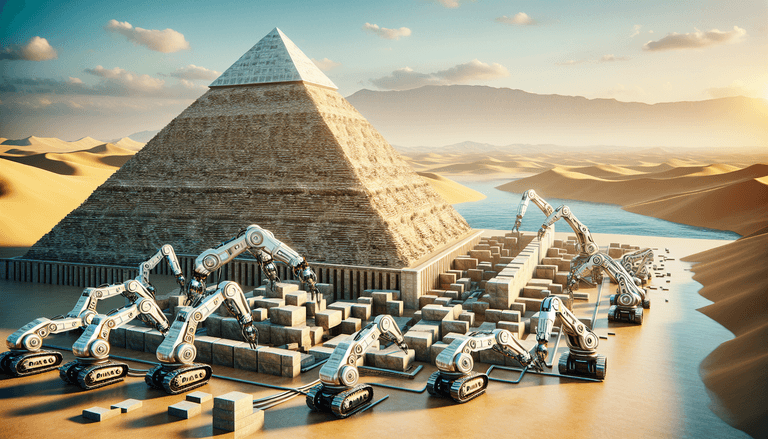Picture this: It’s circa 2550 BC, the sun blazes overhead as throngs of labourers toil under the regal gaze of Pharaoh Khufu. Except, today I’m going to spin you a tale where this timeless scene is injected with a hefty dose of futuristic flair, courtesy of Artificial Intelligence (AI). Yes, dear reader, we’re diving headfirst into an alternate reality where the Egyptians have swapped their chisels and brute force for AI algorithms and machine learning, leaving Elon Musk's robots in the dust.
Architects with Algorithms
In our newfangled Nile-side nirvana, Imhotep, Egypt's legendary master builder and polymath, is not just a man but a veritable whizz with CAD software. Imhotep 2.0 does away with primitive tools, instead utilising cutting-edge AI to predict the best pyramid design based on historical data and human psychology. I mean, who needs natural rock when you can simulate, project, and pivot with the aid of algorithms?
This algorithmic architecture produces pyramids that defy imagination; towering structures which don’t just sit coyly on the desert floor but soar with energy efficiency and one seriously swish aerodynamics. Imagine these leviathans complete with radiant symmetry, and thanks to AI, perfectly aligned not only with the stars but your WiFi connection too!
Siri, Please Direct the Labourers!
Forget primitive levers and pictographic orders! Pharaoh Khufu would’ve dispatched all his logistics through a Siri-esque virtual assistant. "Siri-Ptah," named after Ptah, the god of craftsmen, wouldn’t just organise the workforce like clockwork deficient, but she’d also utter soft reassurances to keep morale high, "You're doing a top-notch job. Pyramid scheme? Who? Us? Never!"
In this parallel universe, communication is seamless, with Siri-Ptah communicating commands through Bluetooth-enabled headdresses, each with instant translation capabilities. Hieroglyphics, be gone! Emoticons would stand as the lingua franca of workers, each sandstone block effectively emoji-labelled for ease of construction.
Sphinx’s Puzzle: AI Enhanced
Imagine the Sphinx, that inscrutable sentinel, not merely a monument, but equipped with the stapled-on smarts to dispense cryptic AI-generated riddles. With facial recognition technology in its stone repertoire, tourists not only get to marvel at its enigmatic smilingness but also engage in real-time intellectual duels. It’s like a blend of IBM’s Watson meets Egypt's Got Talent!
This would potentially gauge humanity's progress, virtue, and affinity for cat GIFs, honouring you with a pyramid selfie should you succeed.
Ancient Algorithms, Modern Melody
No ode to the wonders of AI in ancient Egypt would be complete without a nod to the arts. Musicians armed with rhythm analysing algorithms turn Nile-side gatherings into festive rave-ups. AI DJs like "Ramses-Beat" would churn out hieroglyph-infused tunes that reverberate through time; a rapturous reminder that music truly is a pyramid scheme of the heart.
This fusion of technology and tradition creates the perfect ambience for gatherings in the shadow of these AI-enhanced monuments, the original desert disco, if you will.
A Future Built on the Past
In this mirage of silicon and sand, the Egyptians emerge as pioneers of a strange but marvellously curious civilisation that could well have laid the blueprint for our modern tech society. The majestic pyramids, symbols of eternal repose, might have testimonies of technological triumph etched into their stone.
And thus, dear time travellers in spirit, we conclude our whirlwind tour of an Egypt where the Pharaohs wear digital crowns and the sands whisper the sweet nothings of algorithmic secrets. Who knows, maybe somewhere in the multiverse, Khufu is gleefully testing his Twitter reach.







